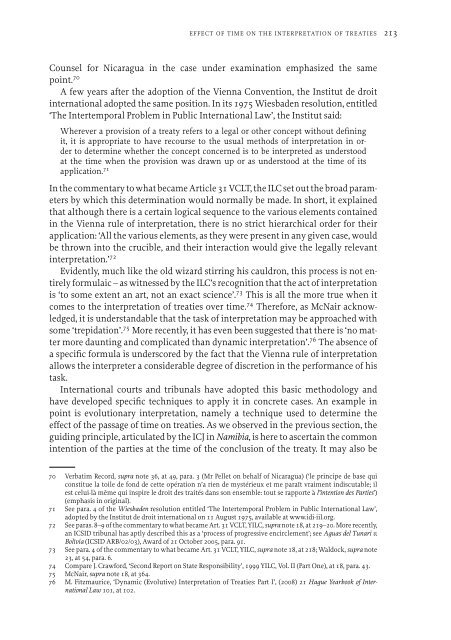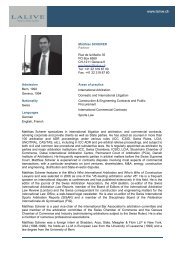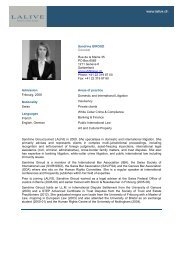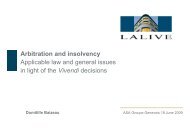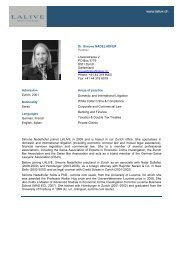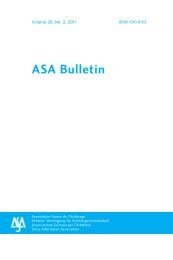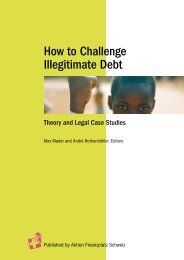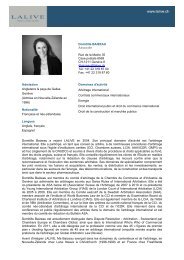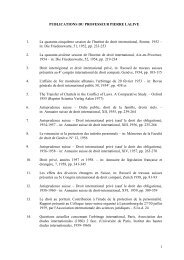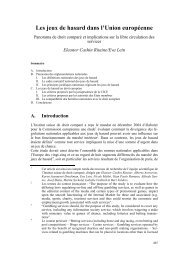The Effect of the Passage of Time on the Interpretation of Treaties ...
The Effect of the Passage of Time on the Interpretation of Treaties ...
The Effect of the Passage of Time on the Interpretation of Treaties ...
You also want an ePaper? Increase the reach of your titles
YUMPU automatically turns print PDFs into web optimized ePapers that Google loves.
EFFECT OF TIME ON THE INTERPRETATION OF TREATIES 213<br />
Counsel for Nicaragua in <str<strong>on</strong>g>the</str<strong>on</strong>g> case under examinati<strong>on</strong> emphasized <str<strong>on</strong>g>the</str<strong>on</strong>g> same<br />
point. 70<br />
A few years after <str<strong>on</strong>g>the</str<strong>on</strong>g> adopti<strong>on</strong> <str<strong>on</strong>g>of</str<strong>on</strong>g> <str<strong>on</strong>g>the</str<strong>on</strong>g> Vienna C<strong>on</strong>venti<strong>on</strong>, <str<strong>on</strong>g>the</str<strong>on</strong>g> Institut de droit<br />
internati<strong>on</strong>al adopted <str<strong>on</strong>g>the</str<strong>on</strong>g> same positi<strong>on</strong>. In its 1975 Wiesbaden resoluti<strong>on</strong>, entitled<br />
‘<str<strong>on</strong>g>The</str<strong>on</strong>g> Intertemporal Problem in Public Internati<strong>on</strong>al Law’, <str<strong>on</strong>g>the</str<strong>on</strong>g> Institut said:<br />
Wherever a provisi<strong>on</strong> <str<strong>on</strong>g>of</str<strong>on</strong>g> a treaty refers to a legal or o<str<strong>on</strong>g>the</str<strong>on</strong>g>r c<strong>on</strong>cept without defining<br />
it, it is appropriate to have recourse to <str<strong>on</strong>g>the</str<strong>on</strong>g> usual methods <str<strong>on</strong>g>of</str<strong>on</strong>g> interpretati<strong>on</strong> in order<br />
to determine whe<str<strong>on</strong>g>the</str<strong>on</strong>g>r <str<strong>on</strong>g>the</str<strong>on</strong>g> c<strong>on</strong>cept c<strong>on</strong>cerned is to be interpreted as understood<br />
at <str<strong>on</strong>g>the</str<strong>on</strong>g> time when <str<strong>on</strong>g>the</str<strong>on</strong>g> provisi<strong>on</strong> was drawn up or as understood at <str<strong>on</strong>g>the</str<strong>on</strong>g> time <str<strong>on</strong>g>of</str<strong>on</strong>g> its<br />
applicati<strong>on</strong>. 71<br />
In <str<strong>on</strong>g>the</str<strong>on</strong>g> commentary to what became Article 31 VCLT, <str<strong>on</strong>g>the</str<strong>on</strong>g> ILC set out <str<strong>on</strong>g>the</str<strong>on</strong>g> broad parameters<br />
by which this determinati<strong>on</strong> would normally be made. In short, it explained<br />
that although <str<strong>on</strong>g>the</str<strong>on</strong>g>re is a certain logical sequence to <str<strong>on</strong>g>the</str<strong>on</strong>g> various elements c<strong>on</strong>tained<br />
in <str<strong>on</strong>g>the</str<strong>on</strong>g> Vienna rule <str<strong>on</strong>g>of</str<strong>on</strong>g> interpretati<strong>on</strong>, <str<strong>on</strong>g>the</str<strong>on</strong>g>re is no strict hierarchical order for <str<strong>on</strong>g>the</str<strong>on</strong>g>ir<br />
applicati<strong>on</strong>: ‘All <str<strong>on</strong>g>the</str<strong>on</strong>g> various elements, as <str<strong>on</strong>g>the</str<strong>on</strong>g>y were present in any given case, would<br />
be thrown into <str<strong>on</strong>g>the</str<strong>on</strong>g> crucible, and <str<strong>on</strong>g>the</str<strong>on</strong>g>ir interacti<strong>on</strong> would give <str<strong>on</strong>g>the</str<strong>on</strong>g> legally relevant<br />
interpretati<strong>on</strong>.’ 72<br />
Evidently, much like <str<strong>on</strong>g>the</str<strong>on</strong>g> old wizard stirring his cauldr<strong>on</strong>, this process is not entirely<br />
formulaic – as witnessed by <str<strong>on</strong>g>the</str<strong>on</strong>g> ILC’s recogniti<strong>on</strong> that <str<strong>on</strong>g>the</str<strong>on</strong>g> act <str<strong>on</strong>g>of</str<strong>on</strong>g> interpretati<strong>on</strong><br />
is ‘to some extent an art, not an exact science’. 73 This is all <str<strong>on</strong>g>the</str<strong>on</strong>g> more true when it<br />
comes to <str<strong>on</strong>g>the</str<strong>on</strong>g> interpretati<strong>on</strong> <str<strong>on</strong>g>of</str<strong>on</strong>g> treaties over time. 74 <str<strong>on</strong>g>The</str<strong>on</strong>g>refore, as McNair acknowledged,<br />
it is understandable that <str<strong>on</strong>g>the</str<strong>on</strong>g> task <str<strong>on</strong>g>of</str<strong>on</strong>g> interpretati<strong>on</strong> may be approached with<br />
some ‘trepidati<strong>on</strong>’. 75 More recently, it has even been suggested that <str<strong>on</strong>g>the</str<strong>on</strong>g>re is ‘no matter<br />
more daunting and complicated than dynamic interpretati<strong>on</strong>’. 76 <str<strong>on</strong>g>The</str<strong>on</strong>g> absence <str<strong>on</strong>g>of</str<strong>on</strong>g><br />
a specific formula is underscored by <str<strong>on</strong>g>the</str<strong>on</strong>g> fact that <str<strong>on</strong>g>the</str<strong>on</strong>g> Vienna rule <str<strong>on</strong>g>of</str<strong>on</strong>g> interpretati<strong>on</strong><br />
allows <str<strong>on</strong>g>the</str<strong>on</strong>g> interpreter a c<strong>on</strong>siderable degree <str<strong>on</strong>g>of</str<strong>on</strong>g> discreti<strong>on</strong> in <str<strong>on</strong>g>the</str<strong>on</strong>g> performance <str<strong>on</strong>g>of</str<strong>on</strong>g> his<br />
task.<br />
Internati<strong>on</strong>al courts and tribunals have adopted this basic methodology and<br />
have developed specific techniques to apply it in c<strong>on</strong>crete cases. An example in<br />
point is evoluti<strong>on</strong>ary interpretati<strong>on</strong>, namely a technique used to determine <str<strong>on</strong>g>the</str<strong>on</strong>g><br />
effect <str<strong>on</strong>g>of</str<strong>on</strong>g> <str<strong>on</strong>g>the</str<strong>on</strong>g> passage <str<strong>on</strong>g>of</str<strong>on</strong>g> time <strong>on</strong> treaties. As we observed in <str<strong>on</strong>g>the</str<strong>on</strong>g> previous secti<strong>on</strong>, <str<strong>on</strong>g>the</str<strong>on</strong>g><br />
guiding principle, articulated by <str<strong>on</strong>g>the</str<strong>on</strong>g> ICJ in Namibia, is here to ascertain <str<strong>on</strong>g>the</str<strong>on</strong>g> comm<strong>on</strong><br />
intenti<strong>on</strong> <str<strong>on</strong>g>of</str<strong>on</strong>g> <str<strong>on</strong>g>the</str<strong>on</strong>g> parties at <str<strong>on</strong>g>the</str<strong>on</strong>g> time <str<strong>on</strong>g>of</str<strong>on</strong>g> <str<strong>on</strong>g>the</str<strong>on</strong>g> c<strong>on</strong>clusi<strong>on</strong> <str<strong>on</strong>g>of</str<strong>on</strong>g> <str<strong>on</strong>g>the</str<strong>on</strong>g> treaty. It may also be<br />
70 Verbatim Record, supra note 36, at 49, para. 3 (Mr Pellet <strong>on</strong> behalf <str<strong>on</strong>g>of</str<strong>on</strong>g> Nicaragua) (‘le principe de base qui<br />
c<strong>on</strong>stitue la toile de f<strong>on</strong>d de cette op erati<strong>on</strong> ´ n’a rien de mystérieux et me paraıt ˆ vraiment indiscutable; il<br />
est celui-làmême qui inspire le droit des traités dans s<strong>on</strong> ensemble: tout se rapporte a`<br />
l’intenti<strong>on</strong> des Parties’)<br />
(emphasis in original).<br />
71 See para. 4 <str<strong>on</strong>g>of</str<strong>on</strong>g> <str<strong>on</strong>g>the</str<strong>on</strong>g> Wiesbaden resoluti<strong>on</strong> entitled ‘<str<strong>on</strong>g>The</str<strong>on</strong>g> Intertemporal Problem in Public Internati<strong>on</strong>al Law’,<br />
adopted by <str<strong>on</strong>g>the</str<strong>on</strong>g> Institut de droit internati<strong>on</strong>al <strong>on</strong> 11 August 1975, available at www.idi-iil.org.<br />
72 See paras. 8–9 <str<strong>on</strong>g>of</str<strong>on</strong>g> <str<strong>on</strong>g>the</str<strong>on</strong>g> commentary to what became Art. 31 VCLT, YILC, supra note 18, at 219–20. More recently,<br />
an ICSID tribunal has aptly described this as a ‘process <str<strong>on</strong>g>of</str<strong>on</strong>g> progressive encirclement’; see Aguas del Tunari v.<br />
Bolivia (ICSID ARB/02/03), Award <str<strong>on</strong>g>of</str<strong>on</strong>g> 21 October 2005, para. 91.<br />
73 See para. 4 <str<strong>on</strong>g>of</str<strong>on</strong>g> <str<strong>on</strong>g>the</str<strong>on</strong>g> commentary to what became Art. 31 VCLT, YILC, supra note 18, at 218; Waldock, supra note<br />
23, at 54, para. 6.<br />
74 Compare J. Crawford, ‘Sec<strong>on</strong>d Report <strong>on</strong> State Resp<strong>on</strong>sibility’, 1999 YILC, Vol. II (Part One), at 18, para. 43.<br />
75 McNair, supra note 18, at 364.<br />
76 M. Fitzmaurice, ‘Dynamic (Evolutive) Interpretati<strong>on</strong> <str<strong>on</strong>g>of</str<strong>on</strong>g> <strong>Treaties</strong>: Part I’, (2008) 21 Hague Yearbook <str<strong>on</strong>g>of</str<strong>on</strong>g> Internati<strong>on</strong>al<br />
Law 101, at 102.


